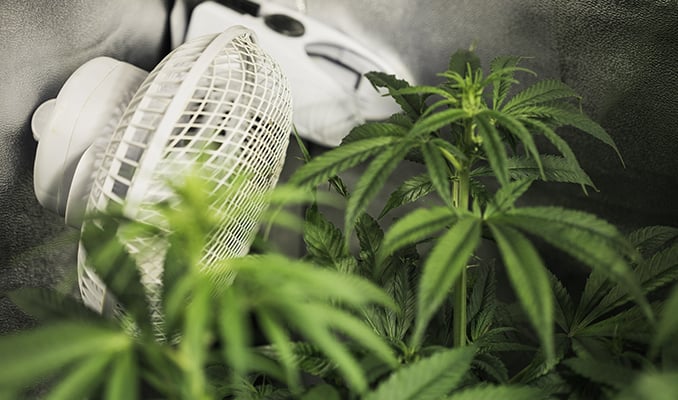The Importance Of Airflow When Growing Cannabis
Published :
Apr 28, 2018
Categories :
Cannabis cultivation

It may come as a surprise to new growers, but airflow is a key element of raising healthy and strong cannabis plants. In an attempt to mimic the natural environment of the herb, airflow systems keep indoor plants resilient and help to deter mould and pests.
Growing cannabis indoors revolves around recreating the optimal natural environment that the herb thrives in. When outdoors, plants are graced by all manner of external stimuli that help them soar to great heights and achieve impressive yields.
Factors such as rain, sunlight, and nutrient-rich soils all contribute to strength, health, and growth. Another factor that helps outdoor plants reach optimal health is a good breeze. The wind serves as an external stressor that toughens up the stems of a plant. But how can we achieve this important factor within an indoor grow operation?
THE IMPORTANCE OF VENTILATION
As well as good lighting, adequate nutrients, and the correct amount of water, indoor plants require a degree of ventilation and air circulation. This can be achieved by setting up fans or installing an exhaust system.
At first consideration, air circulation might seem quite irrelevant, and may reside right at the bottom of the list of priorities for many growers when it comes to their setup. However, that will change once they realise how powerful a mere ventilation system can be for the health of their crop.
Airflow within the growing environment helps to mimic outdoor and natural conditions, and serves many different purposes, even helping to protect precious plants against external threats. Let’s take a closer look at the benefits of airflow within the grow room, and then examine the different ways of achieving it.
STRUCTURAL STRENGTH
The sight of a weak, thin, and dwindling cannabis plant is a sad one indeed. Various factors can contribute to such an unfortunate event, with lack of substantial airflow being one. As with the human body, small amounts of physiological stress usually result in increased resistance to that stress in the future.
Going to the gym, working out, and tearing muscles fibres is an example of this. The muscle will grow back bigger, stronger, and more capable of lifting weight in the future.
Cannabis stems work in a similar way when it comes to the wind. Too much fierce wind could snap a stem, but the constant small gusts and breezes in nature cause the plant to adapt in such a way that its stems becomes thicker and stronger.
This is essential for an indoor grow, especially when flowers grow large and plants struggle to support their own weight.
A SHIELD TO PROTECT AGAINST PESTS AND MOULD
Pests and mould can hinder the health of a cannabis plant severely, and even wipe out an entire crop in some instances. It is in all growers’ best interest to do what they can to deter these invaders from ravaging plants or entering the grow room at all.
Airflow is actually a surprisingly good way of keeping some pests and mould at bay. Many of these creatures thrive in an environment consisting of high levels of humidity, heat, and still air. These conditions are ideal for harmful creatures such as fungus gnats, spider mites, and white powdery mildew.
Having a ventilation system will blow fresh air over your plants and help to prevent occurrences of pests and fungi.
HUMIDITY AND TEMPERATURE
Airflow provided by ventilation within the grow space helps to manage heat and humidity levels, keeping them from getting out of control and becoming detrimental to the growth of your indoor crop. This may help with faster-growing plants that ultimately provide bigger rewards at harvest time.

CREATING AIRFLOW WITHIN THE GROW SPACE
Airflow can be achieved using numerous methods. Perhaps the easiest and cheapest is by simply placing multiple fans within the grow space. Small oscillating fans are great for providing airflow. Ideally, the airflow will be aimed at the canopy of plants, coming from both above and below. Multiple fans are definitely best.
Fans with adjustable settings are ideal. A nice firm breeze is good, but too much force is enough to damage plants and cause leaves to bend into a claw shape. If you have a stronger fan, point it away from plants. It will still provide nice airflow, but you won’t run the risk of damaging your plants.
EXHAUST SYSTEMS
Exhaust systems are also a great option to keep air moving, and to constantly allow fresh air into the grow space. Exhaust systems use fans to pull or push old, stale air out of the grow room or tent.
When setting up an exhaust system, you will need to calculate the cubic area of your grow space. Exhaust fans usually have a CFM rating, meaning cubic feet per minute (which can easily be converted to metric). Preferably, fresh air should be circulated into your grow space every 1–3 minutes.
You will need to work out the volume of your grow space by multiplying the height, width, and length. You will then need an exhaust setup that correlates with this number in terms of CFM.
Carbon filters can also be used in an exhaust system to “scrub” and remove that well-known weed smell. This will help to keep your grow as discreet and secretive as possible. Exhaust fans should be positioned at openings near the top of the tent, with openings at the bottom providing an entrance for fresh air.
If you are only running a small grow operation, it is recommended to keep your exhaust running at all times in order to stop the confined space from becoming too hot and humid. A thermometer and hygrometer can be used to keep readings on both of these values.
Fans may be noisy at times, so to keep volume levels down, consider insulating the area where your tent is placed.






































